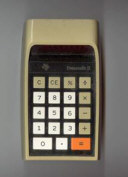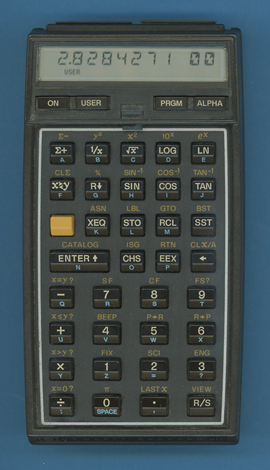
DATAMATH CALCULATOR MUSEUM
 |
DATAMATH CALCULATOR MUSEUM |
Hewlett-Packard HP-41C
| Date of introduction: | July 1, 1979 | Display technology: | LCD 14-segment |
| New price: | $295.00 (SRP 1979) | Display size: | 10 + 2 |
| Size: | 5.7" x 3.1" x
1.20" 144 x 79 x 31 mm3 |
||
| Weight: | 5.8 ounces, 165 grams | Serial No: | 2103A03482 |
| Batteries: | 4*N Alkaline | Date of manufacture: | wk 03 year 1981 |
| AC-Adapter: | Origin of manufacture: | United States | |
| Precision: | 10 | Integrated circuits: | |
| Logic: | RPN | ||
| Memories: | 0-63 | ||
| Program steps: | 441-0 | Courtesy of: | Ken H. Meine |

![]()
![]() The
HP-41C could be called a small revolution in the pocket. Following the path of
Programmable Pocket Calculators like the HP-67 or TI-59
it overcame the limitations of their simple men-machine interface possible with
a numerical keypad and a 7-segment display. The HP-41C added alphanumeric
capabilities to both the display and keyboard using 14-segments and an
ALPHA-key. In addition the memory capacity was enhanced and uses non-volatile
integrated circuits (RAM) like the TI-58C.
The
HP-41C could be called a small revolution in the pocket. Following the path of
Programmable Pocket Calculators like the HP-67 or TI-59
it overcame the limitations of their simple men-machine interface possible with
a numerical keypad and a 7-segment display. The HP-41C added alphanumeric
capabilities to both the display and keyboard using 14-segments and an
ALPHA-key. In addition the memory capacity was enhanced and uses non-volatile
integrated circuits (RAM) like the TI-58C.



![]() A total of 4 slots allowed further expansion of either RAM capacity,
pre-programmed ROM-modules or peripheral devices like a card reader or printer
modules. A clever mechanism allows for snap-in keyboard overlays to further
customize the HP-41C.
A total of 4 slots allowed further expansion of either RAM capacity,
pre-programmed ROM-modules or peripheral devices like a card reader or printer
modules. A clever mechanism allows for snap-in keyboard overlays to further
customize the HP-41C.
The HP-41C still uses the Reverse Polish Notation with the [ENTER] key instead the usual [=] key.
Understanding the game of cat and mouse with Hewlett-Packard, Texas Instruments initiated already in Summer 1977 the "Project X" with clear objectives in mind:
|
• To provide upgrade leadership product to replace TI-59 • Expand concepts of problem solving via calculator device • Incorporate: - State-of-the-art Technologies - System Design - System Expansion • To simplify ease of use and provide market expansion among professionals and end users: - Technical Professionals - Non-Technical Professionals |
The ambitious requirements for "Project X" were finalized in January 1978:
|
• Equation Operating System (EOS) - Equation can be entered without execution - Display will scroll when full - Equation can be edited (Backstep, Insert, Delete) - Equation is saved to be executed or repeated with new data • 16 Character 5*7 dot matrix display - Full alphanumeric display - Equation trace and prompting in the display • More flexible user memory - Basic memory is 1,000 program steps or 125 data registers with partitioning by the user - Solid State Software approach (CROM) has been expanded to include Drop-in RAM (CRAM). - CROMs and CRAMs are interchangeable and two slots are available on the calculator - Basic memory can be expanded to 3,000 steps of 375 data registers - CROMs will be 15k program steps, up to 99 programs per CROM, up to 10k steps per program |
Hewlett-Packard took Texas Instruments by surprise when they introduced with the HP-41C already in July 1979 a Programmable Pocket Calculator almost matching the requirements of their "Project X" - planned for an introduction earliest in Spring 1981! History tells us that TI announced the TI Programmable 88 with CRAM/CROM modules and its peripherals on May 26, 1982 ahead of the Summer Consumer Electronic Show CES, knowing that the polysilicon gate CMOS process used with the TP0485 microcontroller was finally in good shape but the design of the chip still needed some fixes requiring one or two additional manufacturing runs. Consequently the small printed read: "Availability expected late 4th Quarter" and TI cancelled the TI-88 on September 10, 1982 with only a few devices manufactured.


 Learn more about the demanding "Project
X" initiated already in Summer 1977 and leading not only to the (failed) TI
Programmable 88, but the TI-66 PROGRAMMABLE,
failed TI-76 PROGRAMMABLE, Compact Computer
CC 40, (failed Compact Computer CC 70)
and last but not least the successful TI-74
BASICALC and TI-95 PROCALC.
Learn more about the demanding "Project
X" initiated already in Summer 1977 and leading not only to the (failed) TI
Programmable 88, but the TI-66 PROGRAMMABLE,
failed TI-76 PROGRAMMABLE, Compact Computer
CC 40, (failed Compact Computer CC 70)
and last but not least the successful TI-74
BASICALC and TI-95 PROCALC.
It
took some time before Texas Instruments took the leadership again with the
introduction of their first Graphing calculator TI-81 in
1990.
For Hewlett-Packard the HP-41C was a massive success and its upgrade successors HP-41CV with "V" being the Roman Numeral for 5-times the memory capacity and HP-41CX with CV specs plus Time module, were manufactured till November 1990. Even today, more than 40 years after its introduction, the HP-41C family of keystroke Programmable Calculators receives an incredible support from its die-hard community.


 Dismantling the featured HP-41C with
Date code 2103A
manufactured in January 1981 by Hewlett-Packard in the United States reveals a
perfect engineered printed circuit board (PCB) centered around a CPU (Central
Processing Unit) with 56-bit Registers and a 16-bit Program Counter and powered
by 4 N-size batteries.
Dismantling the featured HP-41C with
Date code 2103A
manufactured in January 1981 by Hewlett-Packard in the United States reveals a
perfect engineered printed circuit board (PCB) centered around a CPU (Central
Processing Unit) with 56-bit Registers and a 16-bit Program Counter and powered
by 4 N-size batteries.


 The microprogramming of the CPU is
realized with 3 Instruction-ROMs (Read-only Memories) of 40k Bit capacity, each
for a combined 12k*10-bit program size and communicating with a serial data bus.
User program and user data, both numeric or alphanumeric, are stored in 5 RAMs
(Random-access Memory) of 896 Bits capacity, each for a combined 80 registers
with 64 registers available for the user. The 12-character LC-Display with 14
digit segments, 3 punctuation marks and 1 annunciator space is organized in a 72
Segments * 3 Commons matrix and uses two display drivers bonded in Chip-on-Board
(COB) technology directly to the PCB and covered with a small epoxy blob. An
integrated DC/DC converter generates not only the various voltage supplies for
the main electronics but three different, temperature-compensated voltage levels
for the LC-Display.
The microprogramming of the CPU is
realized with 3 Instruction-ROMs (Read-only Memories) of 40k Bit capacity, each
for a combined 12k*10-bit program size and communicating with a serial data bus.
User program and user data, both numeric or alphanumeric, are stored in 5 RAMs
(Random-access Memory) of 896 Bits capacity, each for a combined 80 registers
with 64 registers available for the user. The 12-character LC-Display with 14
digit segments, 3 punctuation marks and 1 annunciator space is organized in a 72
Segments * 3 Commons matrix and uses two display drivers bonded in Chip-on-Board
(COB) technology directly to the PCB and covered with a small epoxy blob. An
integrated DC/DC converter generates not only the various voltage supplies for
the main electronics but three different, temperature-compensated voltage levels
for the LC-Display.
If you have additions to the above article please email: joerg@datamath.org.
© Joerg Woerner, Januiary 23, 2021. No reprints without written permission.